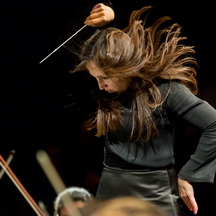Hungarian rapture
The Berkeley-based Chora Nova presented a concert of choral works primarily by Hungarian composer Zoltán Kodály on Sunday, March 22. The second half of the concert, titled “Hungarian Rhapsodies,” presented several of Kodály’s compositions based on Hungarian folk melodies. In his program notes, Artistic Director Paul Flight quotes Kodály on the nature of folk music:
“To write a folksong is as much beyond the bounds of possibility as to write a proverb. Just as proverbs condense centuries of popular wisdom and observation, so, in traditional songs, the emotions of centuries are immortalized in a form polished to perfection.”
Those outside the process of creating a work of art seldom realize the amount of time that goes into that creation. We tend to look only at the integrated whole of the piece, never realizing or re-creating in our minds the process of refinement—of working and reworking—that is crucial to the impact of the finished piece. Similarly, with folksongs, because they are “of a whole cloth” and present in our lives from the very beginnings of our consciousness, we don’t imagine them subjected to a process of refinement. Although he is principally concerned with equating folksongs with cultural emotions, Kodály does us a service to point out that the process of refinement they undergo takes centuries and that lengthy distillation gives them an inviolable wholeness and a sense of inevitability.
Producing a concert is also a creative act. The selection of work, the hours of rehearsal, the learning of foreign sounds and words are all part of a lengthy but invisible process. It’s clear that the members of Chora Nova have spent many hours in the rehearsal hall perfecting the songs they sing. With tonal beauty, dynamic finesse, and rhythmic accuracy, the chorus did Kodály’s work proud.
The second half of the program opened with two short songs based on Kodály’s beloved Hungarian folksongs: “Köszöntö” (Birthday Song) and “Esti Dal” (Evening Song). Both were richly arranged, their ancestry lively and unmistakable. In the latter, which is a prayer rather like that from Humperdinck’s Hansel und Gretel, the sopranos assumed the bell-like tones of children, the lower voices in the chorus humming underneath like a drone. Notes rose like sparkling fragments, all four parts joining finally into a rich hum.
More intriguing was the Kálló Folk Dances, a set of three songs that blend into one long piece, starting with a slow foot-dragging dance rhythm and ending with a wild whirl that grows reckless in fervor. All of the songs dabble in the fickleness of love: “How was I to know Love could bring such pain and woe!”
The folk dances were accompanied by an engaging ensemble of violin, cello, two clarinets and piano.
In the opening song, the lines are divided between the male and female voices, which alternate between storytelling and rhythmic syllables: “ah, ah!” “bump, bump!” The effect is intricate, ironic and pleasing.
The chorus chose to sing the lyrics in English, which may have caused some difficulties for the singers but was helpful for the audience’s understanding. Hungarian is normally accented on the first syllable of every word, giving it a natural syncopation. English, on the other hand, tends toward the iambic, and American toward the four-beat line. Neither is ideal for Hungarian songs. Even so, First Congregational’s reverberant acoustic tends to diminish clarity in language, making inflection a moot issue.
The hall’s acoustic was ideal for the first half of the program, however, which featured Kodály’s lovely Missa Brevis. What is most winning about the piece is the use of soloists in attractive groupings against the velvety harmonies of the chorus. Throughout the piece, lower-voiced soloists were counterbalanced by a sky-high-voiced trio of sopranos. Splendid tenor Jimmy Kansau and baritone Paul Murray were accomplished in their solo work, and my hat’s off to sopranos Ann Moss, Nalini Ghuman and Lauren Schekman, who were spine tingling in their stratospheric excesses. Kodály used dissonance in the soprano harmonies, creating a concert-hall version of the vocal sounds that have made their way into contemporary Balkan women’s choral music, giving it a characteristically haunting quality.
Most impressive was contralto Ruthann Lovetang, whose vocal tone is remarkably beautiful.
The program opened with Felix Mendelssohn’s gorgeous eight-part “Ave Maria” in a salute to the composer during this year’s second centenary of his birth.
—Jaime Robles
Originally published in the Piedmont Post
